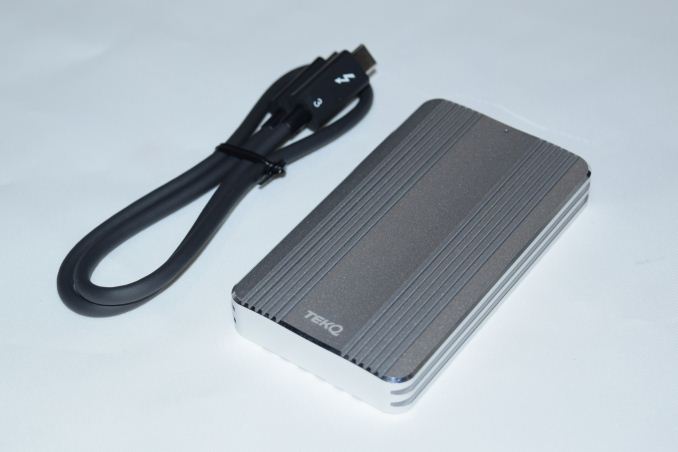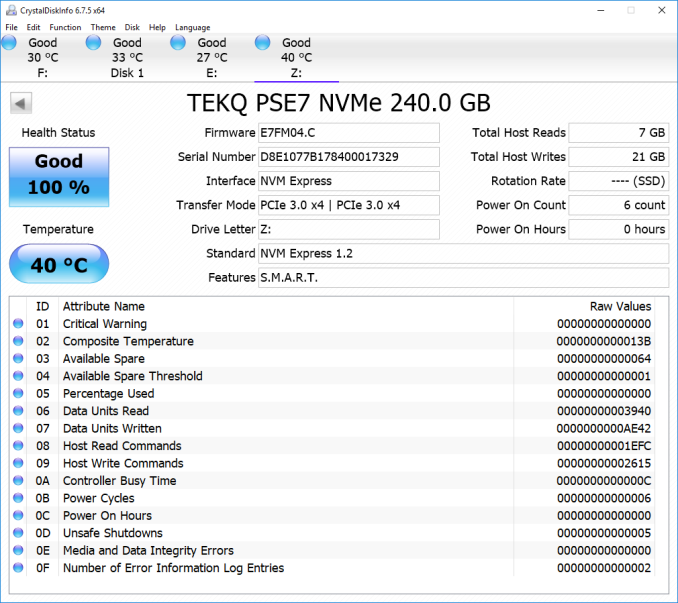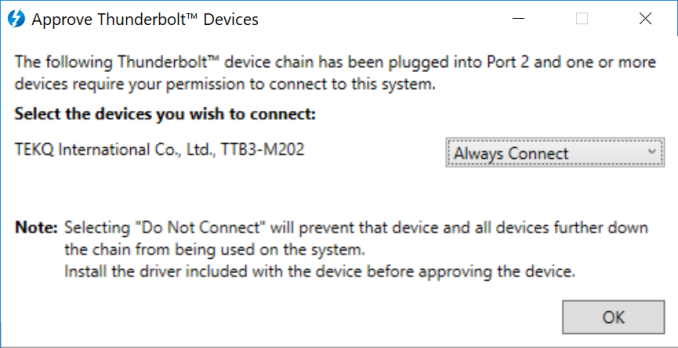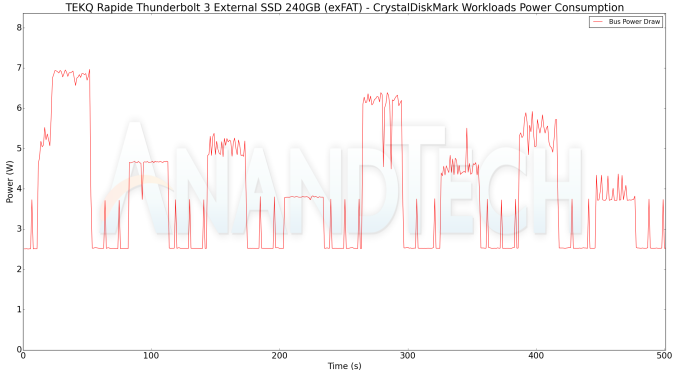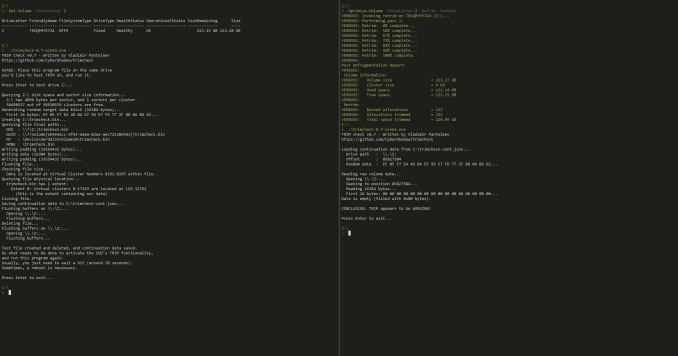
Original Link: https://www.anandtech.com/show/12443/tekq-rapide-thunderbolt-3-external-ssd-review
TEKQ Rapide Thunderbolt 3 External SSD Review
by Ganesh T S on February 20, 2018 8:00 AM EST- Posted in
- Storage
- SSDs
- DAS
- Thunderbolt 3
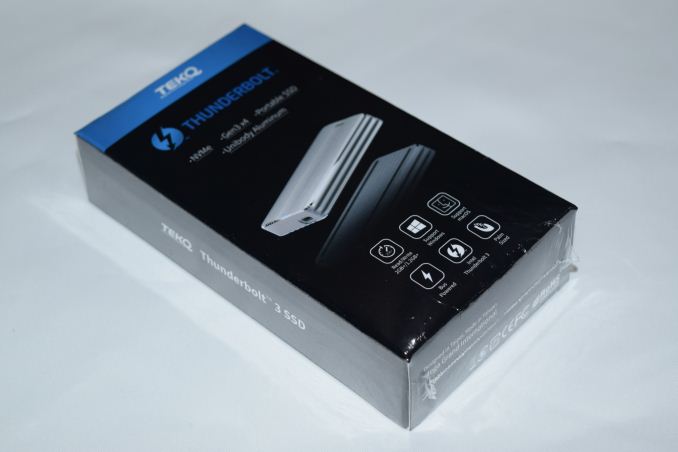
Flash-based external direct-attached storage (DAS) devices have evolved rapidly over the last few years. Starting with simple thumb drives that could barely saturate USB 2.0 bandwidth, we now have high-performance external SSDs that take advantage of the USB 3.1 Gen 2 interface to saturate the internal SATA bandwidth. The introduction of PCIe-based SSDs have enabled mass-market storage devices to break the SATA barrier. The proliferation of Thunderbolt 3 (that drives up the available bandwidth by a factor of four compared to USB 3.1 Gen 2) has ensured that the full performance benefits of the internal PCIe interface can be made available in external devices.
A number of high-performance direct-attached storage (DAS) devices have attempted to take advantage of the benefits of Thunderbolt in the last few years. However, they have either required external power adapters (such as the LaCie d2 Thunderbolt 2 SSD Upgrade), or, in the case of bus-powered devices, been held back by an internal SATA SSD (eg.: LaCie Rugged Thunderbolt). The pricing of such devices have also restricted them to the high-end / professional market. In this context, the introduction of a reference platform by Phison at CES 2018 is sure to address the shortcomings of the current external Thunderbolt SSDs in the mainstream market.
Introduction
TEKQ has been in business as a manufacturer of Apple MFI-certified peripherals for some time now. They are new to the direct-attached storage space, but, their first product in that market segment - the Rapide Thunderbolt 3 External SSD - leapfrogs most of the other bus-powered alternatives in the market in terms of both performance and pricing.
The TEKQ Rapide is a 98mm x 45mm x 12mm silver-colored external SSD with an aluminum chassis. It sports a single Thunderbolt 3 interface for both power and data. The port is enabled by the Intel DSL6340 Thunderbolt 3 Controller - note that this belongs to the Alpine Ridge family, and hence, works only with Thunderbolt 3 Type-C ports. On the other side of the DSL6340 is a PCIe 3.0 x4 connection that leads to a M.2 slot capable of accommodating M.2 2260 or 2280 PCIe SSDs. There are no plastic components in the chassis.
There is nothing preventing advanced users from installing their own M.2 PCIe SSDs in the internal M.2 slot. However, TEKQ plans to sell the Rapide in three different capacity points - 240GB, 480GB, and 960GB. Based on our teardown, the internal SSD doesn't seem to be a branded one. Instead, it appears to be a Phison reference design using the E7 controller along with Toshiba's MLC NAND flash.
Unlike similar products such as OWC Envoy Pro EX / EX(VE) that are available for retail purchase right now, TEKQ has opted to go for the crowdfunding route to garner more exposure prior to a wide market release. As a matter of policy, AnandTech does not cover crowdfunding projects. There are very few exceptions - most of the ones that pass our bar are ones where the product is close enough to the launch that manufacturers are ready to have us post a hands-on review of the product. The TEKQ Rapide is one such device. TEKQ's crowdfunding initiative will go live on Feb. 21, 2018.
TEKQ sent over the 240GB variant for review. In addition to the main unit, a 0.5m Thunderbolt 3 cable (certified for 40 Gbps operation) is also bundled.
The TEKQ Rapide is around the size of a credit card, and weighs 135g. With TEKQ's own internal SSD solution, read/write speeds of 2700 MBps / 1500 MBps are claimed, with the random read/write IOPS coming in at 300K/250K respectively.
Prior to looking at the internals, CrystalDiskInfo provides some insights.
Even though CrystalDiskInfo puts only SMART in the features section, we will see later on that TRIM is also supported. The Thunderbolt link is essentially invisible to the tool, with NVM Express listed as the interface. For all practical purposes, the TEKQ Rapide SSD is a PCIe 3.0 x4 NVMe SSD in the system.
Internal Hardware
The TEKQ Rapide is easy to disassemble, with four screws hidden under the rubber feet on the underside of the chassis. The gallery below has pictures of the chassis as well as the internal design and M.2 SSD. The Phison controller and the Toshiba MLC flash are easily seen in the M.2 SSD.
The design includes thermal pads for both the M.2 SSD and the Thunderbolt 3 controller. As we shall see later on, the thermal solution is very effective in keeping the internal temperatures under check even under stressful conditions beyond what a consumer-focused DAS unit might endure.
Usage Impressions
The TEKQ Rapide is plug-and-play except for the small matter of allowing Thunderbolt security to allow one's system to act as a host for the device.
Once approved (needs to be done only once per system if the 'Always Connect' option is chosen), the device mounts as a exFAT volume. This allows for compatibility with both Mac and Windows devices. Since the Thunderbolt 3 / NVMe SSD breezed through our benchmarks in very little time, we were able to evaluate the unit with the volume formatted in exFAT and NTFS.
Unlike some of the other portable SSDs in the market that come with value-adds such as hardware encryption support, the TEKQ is currently keeping it simple. Despite the underlying platform (Phison E7 reference design with Toshiba 15nm MLC flash) supporting AES-256 with TCG / Opal 2.0, the feature doesn't have any user-friendly way to get activated.
Synthetic Benchmarks
Various synthetic benchmarks are available to quickly evaluate the performance of direct-attached storage devices. Real-world performance testing often has to be a customized test. We present both varieties in this review, starting with the synthetic benchmarks in this section. Prior to covering those, we have a quick look at our testbed setup and testing methodology.
Testbed Setup and Testing Methodology
Evaluation of DAS units on Windows is done with the testbed outlined in the table below. For devices with a Thunderbolt 3 Type-C interface (such as the TEKQ Rapide that we are considering today), we utilize the Thunderbolt 3 port enabled by the Intel Alpine Ridge controller. It connects to the Z170 PCH via a PCIe 3.0 x4 link.
| AnandTech DAS Testbed Configuration | |
| Motherboard | GIGABYTE Z170X-UD5 TH ATX |
| CPU | Intel Core i5-6600K |
| Memory | G.Skill Ripjaws 4 F4-2133C15-8GRR 32 GB ( 4x 8GB) DDR4-2133 @ 15-15-15-35 |
| OS Drive | Samsung SM951 MZVPV256 NVMe 256 GB |
| SATA Devices | Corsair Neutron XT SSD 480 GB Intel SSD 730 Series 480 GB |
| Add-on Card | None |
| Chassis | Cooler Master HAF XB EVO |
| PSU | Cooler Master V750 750 W |
| OS | Windows 10 Pro x64 |
| Thanks to Cooler Master, GIGABYTE, G.Skill and Intel for the build components | |
The full details of the reasoning behind choosing the above build components can be found here. The list of DAS units used for comparison purposes is provided below. Not all benchmarks are available for all units, as our testing has evolved over the years, and more than three years have passed since the LaCie Rugged Thunderbolt and the d2 Thunderbolt 2 - SSD were evaluated. It must also be kept in mind that those two devices were evaluated using the Thunderbolt 2 port from our Z97-based Haswell testbed.
- TEKQ Rapide Thunderbolt 3 SSD 240GB (exFAT)
- TEKQ Rapide Thunderbolt 3 SSD 240GB (NTFS)
- LaCie Rugged Thunderbolt 500GB
- LaCie d2 Thunderbolt 2 - SSD 128GB
Synthetic Benchmarks - ATTO and Crystal DiskMark
TEKQ claims read and write speeds of 2700 MBps and 1500 MBps respectively, and these are backed up by the ATTO benchmarks provided below. Unfortunately, these access traces are not very common in real-life scenarios.
| Drive Performance Benchmarks - CrystalDiskMark | ||
/CDM.png) |
||
AnandTech DAS Suite and Performance Consistency
This section looks at how the TEKQ Rapide behaves when subject to real-world workloads.
Benchmarks - robocopy and PCMark 8 Storage Bench
Our testing methodology for DAS units also takes into consideration the usual use-case for such devices. The most common usage scenario is transfer of large amounts of photos and videos to and from the unit. The minor usage scenario is importing files directly off the DAS into a multimedia editing program such as Adobe Photoshop.
In order to tackle the first use-case, we created three test folders with the following characteristics:
- Photos: 15.6 GB collection of 4320 photos (RAW as well as JPEGs) in 61 sub-folders
- Videos: 16.1 GB collection of 244 videos (MP4 as well as MOVs) in 6 sub-folders
- BR: 10.7 GB Blu-ray folder structure of the IDT Benchmark Blu-ray
| Performance Consistency and Thermal Characteristics | ||
/PCON.png) |
/PCON.png) |
|
It can be seen that the temperature of the internal SSD does not cross 60C at any point during the performance consistency testing. There are no throttling aspects to worry about, though the exFAT configuration does suffer some hiccups during the last few transfer sets compared to the NTFS version. This hiccup is also reflected in the numbers presented in the graphs of the preceding sub-sections.
Miscellaneous Aspects and Concluding Remarks
The Thunderbolt 3 specifications indicate that the host port must be able to supply up to 15W for bus-powered devices connected to it. Since the TEKQ Rapide is a bus-powered device, it is given that its power consumption can't exceed 15W in order to be a certified Thunderbolt 3 device. It is still relevant to take a fine-grained look at the power consumption profile. Using the Plugable USBC-TKEY, the bus power consumption for the external SSD was tracked while the CrystalDiskMark workloads were processed. The workloads were set up with an interval time of 30s. The power consumption was tracked only for the exFAT version of the CrystalDiskMark workloads.
We find that the peak power consumption is slightly south of 7W. The SSD idles at around 2.5 W.
Support for TRIM is an important aspect - it ensures that performance consistency is maintained even after the SSD has been subject to long-term use. Since the Thunderbolt interface is transparent for all practical purposes, and the host OS sees a PCIe NVMe SSD, it comes down to the Phison E7 reference design supporting TRIM. We were able to successfully activate TRIM on the TEKQ Rapide.
The final aspect that we deal with in the review is the pricing. TEKQ sent over the following pricing table for the three variants.
| TEKQ Rapide Thunderbolt 3 External SSDs - Pricing | |||
| Capacity | Retail | Indiegogo | Amazon |
| 240 GB | $319 | $255 | $300 |
| 480 GB | $479 | $383 | $450 |
| 960 GB | $899 | $719 | $900 |
There are very few bus-powered Thunderbolt 3 external SSDs currently in the market, though a number of them have been announced recently. The only current alternative to the TEKQ Rapide in its price range is the OWC Envoy Pro EX / EX(VE). The 250GB variant of the OWC unit comes in at $280, which is much cheaper than the TEKQ Rapide. That said, the Envoy Pro EX tops out at 1800 MBps. The EX(VE) goes up to 2600 MBps, but carries a hefty price premium. The TEKQ does guarantee a M.2 SSD with MLC NAND flash. While OWC doesn't clarify that aspect for either of their Envoy Pro offerings, it appears likely that the EX uses TLC, while the EX(VE) uses MLC flash. Most of the upcoming Thunderbolt 3 external SSDs are going to be based on the Phison E8 reference design with 3D TLC. In this context, a MLC external SSD such as the TEKQ Rapide is bound to appeal better to a section of the market.
While taking up the review unit, I was expecting to wade through the usual beta-testing bugs (particularly given that TEKQ had not released any high-performance external storage devices before). I was pleasantly surprised that all our tests were processed without a hitch. The performance of the TEKQ Rapide is top-notch and meets the claimed numbers. Adding a user-friendly way to activate the hardware encryption capabilities of the internal SSD would be a nice feature to have, but, it is a minor nit-pick. Our main concern is the pricing (compared to the TLC-using competition in the market) and the availability of flash for TEKQ to ramp up volume and make the device more economical to address the mainstream market.

